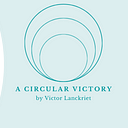8.6% of the world is Circular
Hi all and welcome back to the 18th blog post of a Circular Victory! Last week we talked about the importance of designers and the role they can play in the evolution towards a more Circular Economy. We developed a few questions that designers can ask throughout the starting stages so that they can develop a product that meets the Circular standards. If you are interested to hear more about that, you can find the 17th blog post here.
This week we are going to look at the report by “Circle Economy” in which they are reporting on the current state of Circularity.
The state of Circularity
“Circle Economy” is a non-profit research institution that has the mission to “accelerate the practical and scalable implementation of the Circular Economy”. This institution publishes a yearly “Circularity Gap Report”. The major conclusion of this year’s report is the fact that the world is currently 8.6% Circular. In the report, this is portrayed as very low, but for me personally, this number was a pleasant surprise. While I see many sustainable efforts around me, both from companies and individuals, it does often not feel like this has a significant impact. Seeing that number of 8.6% makes me more hopeful. Changes are already happening and they are far from slowing down. If anything, Circularity is speeding up and adoption is becoming more mainstream everywhere.
The report then goes on to give even more hopeful numbers. Roughly doubling the global Circularity to 17% would put us well below the target temperatures of a 2-degree increase by 2032.
This is where the report also shows the strengths of the Circular Economy. Usually, we associate decreasing the temperature increase with having to give up on a lot of the lifestyle we have gotten used to. The Circular Economy helps us with this. Circularity promises to do more with less. By applying smart strategies and reducing material consumption we can significantly cut greenhouse emissions and virgin resource use while still satisfying societal wants and needs.
This report is another argument for increased Circularity and we can all help to achieve this 17% of Circularity in our own way. We can all vote with our wallets, use things a little longer, repair before we buy something new and so on. We can do this, there is hope and there are clear steps to take!
Let’s get to 17% as soon as we can!
You can find the report here:
https://circularity-gap.world/2021
